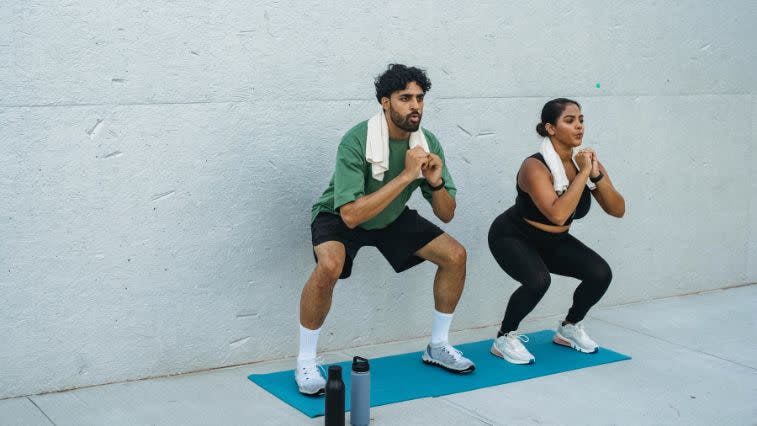The Truth About How to Get Lean Instead of Bulky, According to a Personal Trainer
Our content strives to support, inform, and motivate you to meet your health goals. We want to be your trusted source of expert- and science-backed info dispensed in simple, actionable ways. Read our Editorial Guidelines.
As an avid weightlifter and personal trainer, I know the benefits of strength training. As a female, I also know it takes years of dedicated, consistent training to gain a substantial amount of noticeable muscle mass. But, many of my female clients are intimidated by lifting weights, especially heavy ones, in fear of becoming “bulky.”
I’m here to tell you that will not happen.
As for males, yes, you can develop more muscle mass much more quickly and readily than women, but becoming bulky instead of lean is not the inevitable outcome you might think it is. If you’re interested in obtaining a lean look that isn’t “bulky,” there are ways you can eat and train to encourage that particular outcome, regardless of sex.
Defining Lean vs. Bulky

First, I would be remiss if I didn’t address this issue: Women should not be afraid of taking up space. We shouldn’t constantly try to shrink ourselves or use exercise only to become smaller and thinner. In fact, many women don’t realize that the body type they covet is likely obtained by gaining muscle mass.
When clients ask me how they can get lean instead of bulky, I immediately ask them to define both terms. These people often believe lifting weights will cause them to gain muscle and look thick, wide, and heavy. While this could technically happen if you’re male or tend to gain muscle easily, it’s not inevitable. Far from it.
When clients say they want to be lean, they typically hope to reduce body fat while having visible muscles. For women, this usually means shapely glutes, legs, and abdominals. For men, it’s most often the arms, chest, abs, and calves.
The secret is while gaining muscle and losing body fat at the same time is possible, a lean, muscular look is not obtained by one single type of training. In fact, it takes quite a long time of dedicated and consistent work to grow muscle and shed body fat in separate phases of training and dieting strategies. It sounds complicated, but it’s not, I promise.
How to Get Lean and Muscular
While a complete program is beyond the scope of this article, the basics are this:
Lift weights in a hypertrophy-based (strength-building) program that increases volume over time.
Eat more calories than you burn, with plenty of protein to support muscle growth.
Don’t overtrain; allow time for your muscles to recover and grow.After a period of muscle growth and calorie surplus, start reducing calories slightly to lose body fat.
Continue lifting weights and training in ways that challenge you while eating enough protein to spare your muscle during the calorie cutback.
Once you reach your desired body fat levels or feel diet fatigue, stop dieting.
Repeat the process, gaining more muscle over time.
When you see people with low body fat levels and visible muscles, such as bodybuilders, they’ve likely completed this process a few times. The more muscle they have, the longer they have probably been doing this type of programming. It also helps to have incredible genetics, be young, and have excellent coaching and training.
And keep in mind bodybuilders don’t look lean at all times. They complete cycles of muscle growth called “bulking” or “massing” and then reduce body fat in a separate phase. What you see in images is a carefully curated look that’s not their typical body. Staying at a very low body fat percentage can cause numerous health issues and is not recommended.
Getting Bulky Instead of Slimming Down
If you’ve been lifting weights and feel you’re only getting bulky and not slimming down, this is likely because you’re successfully gaining muscle — congratulations! Gaining muscle is most effectively accomplished by eating more than you’re burning, which means you won’t shed body fat during this time. But this can be a good thing!
Too many people make the mistake of focusing only on weight loss and the number on the scale. To achieve a lean, muscular look, you can’t only focus on losing weight. Weight loss will always come with some muscle loss, along with the body fat you’re aiming to shed.
In other words, weight loss is not always the best goal for everyone. But, if your doctor has recommended it or you know you have some extra body fat contributing to poor health, it can be an ideal goal. In this case, strength training is still incredibly valuable and will help you increase your metabolism. You may even build muscle while you lose weight, especially if you’re new to weight lifting.
If your main goal is to lose body fat:
focus on strength training
increase your overall daily activity by walking
do some cardio
ensure you eat in a reasonable calorie deficit with whole foods that include plenty of fiber and protein from whole grains, lean proteins, fruits, and veggies.
After you reach your desired body fat level, you can build muscle by increasing your calories back up to maintenance level (the number of calories you need to keep your weight stable) or a slight calorie surplus to support muscle gain.
Achieving Lean (Not Bulky) Arms and Legs

The above advice applies to any body part, but clients are often most concerned with their arms and legs looking bulky from lifting weights. Many people think they should stick to Pilates or yoga instead of lifting weights to achieve “long, lean” muscles instead of adding “bulk.”
I’m here to tell you that no exercise on the planet can increase the physical length of your muscles. Muscles have specific origins and insertions on your body; no matter how many Pilates hundreds you do, you can’t change these physical properties.
Pilates is an excellent form of exercise that can help you build strength and muscular endurance, so it’s worth considering if you enjoy it. But, it won’t be enough to help you grow much muscle, and it doesn’t burn significant calories to support weight loss. Choose Pilates because you enjoy it and it improves your posture and core stability, not because you believe it will create a “long” or “toned” physique.
That said, if you’re hoping to achieve lean, muscular, but not bulky arms and legs, strength training will certainly help. Working your arms and legs twice each week is a fantastic starting place. Complete three to six sets of exercises targeting the different muscles of your legs and arms each week, eat well, and increase your overall activity levels to support a healthy and lean physique.
Final Message
Please don’t be afraid of gaining weight during a muscle-massing phase. Although many of us (especially women) have been conditioned to strive for lower and lower numbers on the scale, this is not the way to achieve a lean, “toned” look. Be patient with your body and aim to gain muscle over time by training correctly and fueling your body.
Short, intermittent stints of fat loss can help you achieve the leanness you’re hoping for, but it’s crucial for your health and wellbeing to stick primarily to eating at maintenance or in a slight surplus for most of the time. Your body will thank you.
Learn what specific changes you may need to make to your workout routine and diet to get a lean look. Sign up for a free consultation with a certified personal trainer today.